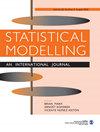logistic混合模型中混合分布非参数估计的顶点交换方法
IF 1.2
4区 数学
Q2 STATISTICS & PROBABILITY
引用次数: 0
摘要
传统的logistic混合模型中随机效应分布的正态性假设在某些应用中可能过于严格。在我们对澳大利亚妇女就业参与的纵向研究的数据示例中,由于潜在的移动-停留情景,随机效应表现出非常态性。在这种情况下,观察到的女性在研究期间保持相同的初始反应状态可能包括两个亚组:潜在的停留者-那些极有可能转变反应状态的人-和潜在的移动者,那些有可能转变反应状态的人。以前已经强调了使用非参数方法估计随机效应和移动-停留模型之间的相似性。我们探索非参数的方法来模拟单变量和双变量随机效应在一个潜在的移动-停留情景。由于有有限的方法可用于拟合logistic混合模型中二元随机效应的非参数最大似然估计,我们实现了顶点交换方法(VEM)来估计logistic混合模型中的随机效应。由VEM算法导出的非参数最大似然估计的近似值使随机效应具有更大的灵活性,在我们的数据示例中识别出非就业类别中潜在滞留者对应的区域。本文章由计算机程序翻译,如有差异,请以英文原文为准。
Vertex Exchange Method for non-parametric estimation of mixing distributions in logistic mixed models
The conventional normality assumption for the random effects distribution in logistic mixed models can be too restrictive in some applications. In our data example of a longitudinal study modelling employment participation of Australian women, the random effects exhibit non-normality due to a potential mover–stayer scenario. In such a scenario, the women observed to remain in the same initial response state over the study period may consist of two subgroups: latent stayers—those with extremely small probability of transitioning response states—and latent movers, those with a probability of transitioning response states. The similarities between estimating the random effects using non-parametric approaches and mover–stayer models have previously been highlighted. We explore non-parametric approaches to model univariate and bivariate random effects in a potential mover–stayer scenario. As there are limited approaches available to fit the non-parametric maximum likelihood estimate for bivariate random effects in logistic mixed models, we implement the Vertex Exchange Method (VEM) to estimate the random effects in logistic mixed models. The approximation of the non-parametric maximum likelihood estimate derived by the VEM algorithm induces more flexibility of the random effects, identifying regions corresponding to potential latent stayers in the non-employment category in our data example.
求助全文
通过发布文献求助,成功后即可免费获取论文全文。
去求助
来源期刊

Statistical Modelling
数学-统计学与概率论
CiteScore
2.20
自引率
0.00%
发文量
16
审稿时长
>12 weeks
期刊介绍:
The primary aim of the journal is to publish original and high-quality articles that recognize statistical modelling as the general framework for the application of statistical ideas. Submissions must reflect important developments, extensions, and applications in statistical modelling. The journal also encourages submissions that describe scientifically interesting, complex or novel statistical modelling aspects from a wide diversity of disciplines, and submissions that embrace the diversity of applied statistical modelling.
 求助内容:
求助内容: 应助结果提醒方式:
应助结果提醒方式:


